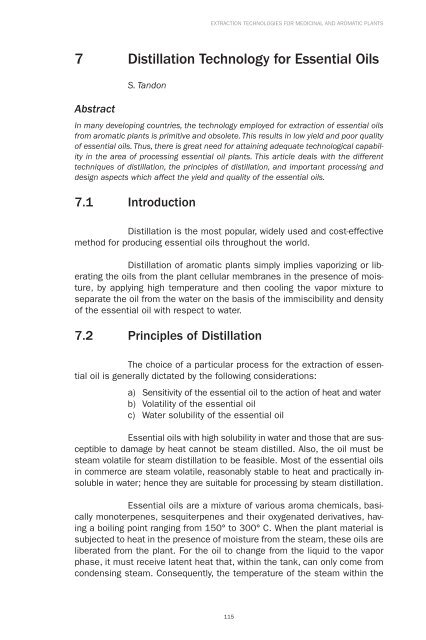Extraction Technologies For Medicinal And Aromatic Plants - Unido
Extraction Technologies For Medicinal And Aromatic Plants - Unido
Extraction Technologies For Medicinal And Aromatic Plants - Unido
Create successful ePaper yourself
Turn your PDF publications into a flip-book with our unique Google optimized e-Paper software.
EXTRACTION TECHNOLOGIES FOR MEDICINAL AND AROMATIC PLANTS<br />
7 Distillation Technology for Essential Oils<br />
Abstract<br />
S. Tandon<br />
In many developing countries, the technology employed for extraction of essential oils<br />
from aromatic plants is primitive and obsolete. This results in low yield and poor quality<br />
of essential oils. Thus, there is great need for attaining adequate technological capability<br />
in the area of processing essential oil plants. This article deals with the different<br />
techniques of distillation, the principles of distillation, and important processing and<br />
design aspects which affect the yield and quality of the essential oils.<br />
7.1 Introduction<br />
Distillation is the most popular, widely used and cost-effective<br />
method for producing essential oils throughout the world.<br />
Distillation of aromatic plants simply implies vaporizing or liberating<br />
the oils from the plant cellular membranes in the presence of moisture,<br />
by applying high temperature and then cooling the vapor mixture to<br />
separate the oil from the water on the basis of the immiscibility and density<br />
of the essential oil with respect to water.<br />
7.2 Principles of Distillation<br />
The choice of a particular process for the extraction of essential<br />
oil is generally dictated by the following considerations:<br />
a)<br />
b)<br />
c)<br />
Sensitivity of the essential oil to the action of heat and water<br />
Volatility of the essential oil<br />
Water solubility of the essential oil<br />
Essential oils with high solubility in water and those that are susceptible<br />
to damage by heat cannot be steam distilled. Also, the oil must be<br />
steam volatile for steam distillation to be feasible. Most of the essential oils<br />
in commerce are steam volatile, reasonably stable to heat and practically insoluble<br />
in water; hence they are suitable for processing by steam distillation.<br />
Essential oils are a mixture of various aroma chemicals, basically<br />
monoterpenes, sesquiterpenes and their oxygenated derivatives, having<br />
a boiling point ranging from 150° to 300° C. When the plant material is<br />
subjected to heat in the presence of moisture from the steam, these oils are<br />
liberated from the plant. <strong>For</strong> the oil to change from the liquid to the vapor<br />
phase, it must receive latent heat that, within the tank, can only come from<br />
condensing steam. Consequently, the temperature of the steam within the<br />
115

















